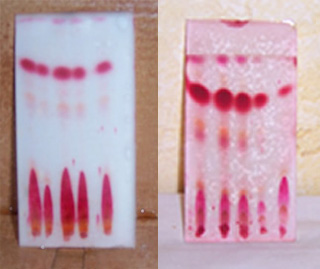Why should you use HPTLC for botanical identification?
Other techniques can address identification only in part. They either are limited to plant
parts (microscopy), have difficulties with natural variability of botanical materials (IR
techniques), or focus on the quantitative comparison of separated markers (HPLC).
All other techniques lack the versatility and flexibility of HPTLC for the analysis of
botanicals. HPTLC is the ONLY single technique that offers a generally applicable approach
to compliance with the FDA requirement of 100% botanical identification.
HPTLC is the primary chemical test for identification of all pharmacopoeia monographs on
botanicals (including USP)
The acceptance and performance of HPTLC is demonstrated by the China HPTLC Atlas, AHP
monographs, and the USP Dietary Supplement Compendium
HPTLC fingerprints do not just give a correlation coefficient but visually show the
similarities and differences between samples and references on the same plate.
In addition to identity an HPTLC fingerprint can also give quantitative information
(intensity of bands) about a sample for batch to batch comparison HPTLC can also be used for
assays (potency), purity (adulteration), and stability studies (shelf life) HPLC testing is
more time consuming and have limited detectability of non-UV absorbing compounds Unlike
HPLC, HPTLC preserves the complete sample for analysis, so nothing is “hidden”.
Here is the way we see it. These kits give THC results that have been
compared to a properly run and managed GC machine on a monthly basis and even clients with
no testing backgrounds have tested with the kits and have had no more than 1% difference
from the GC machine. Working with experienced chemists the conclusion has been that if you
are going to make any type of products for sale, you will need to do many test on your
substances for batching and dosage for medical use, or you are just going to retail products
from liquids to hand creams, all these substances will have to be tested in the USA before
going to retail.
It is not cost effective for any large or small company to spend a lot of money going to a
lab for continues testing. Our kits used properly will give you consistent results if you
use the correct amount stated for testing, so that you can create your substances or track
your breeding for very little cost. Then once you have gotten your product to where you want
it then you can go to a certified lab and have it tested so it can go to retail which will
be the law that all substances will have to be tested by a certified lab at some point. Many
labs are using our test kits already, some labs use our testing procedure and use no
machines so instead of paying tons of money for initial testing using our kits is a sensible
part of processing any type of cannabis product or substance, and some labs are telling
clients to use the kits first and then come to them for final testing. It is a win win for
everybody. Once you understand TLC testing you will see that it will become a standardized
part of the cannabis industry.


